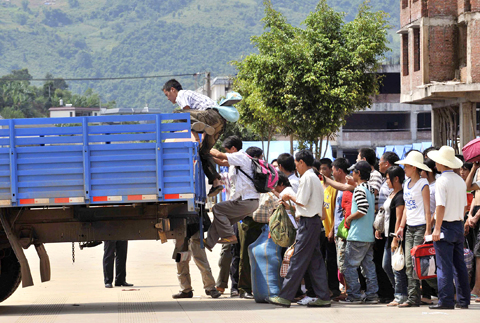Refugees who fled Myanmar into China after deadly clashes between junta forces and ethnic rebels trickled back across the border yesterday, but some said they feared going home to more unrest.
Officials in China’s southwestern Yunnan Province said 37,000 refugees had streamed into the country following days of fighting in Kokang, a mainly ethnic Chinese region of Myanmar’s Shan state.
Eight rebel fighters and 26 security forces were killed in the clashes in Myanmar’s remote northeast, state media reported late on Sunday, saying the unrest had ended. Two Chinese nationals were also killed, officials said.

PHOTO: REUTERS
At the border crossing in the Chinese town of Nansan, refugees were crossing into Myanmar in groups of about 40 at a time, Agence France-Presse (AFP) reporters witnessed. The occasional person came into China.
“The Myanmar government has told us through diplomatic channels to send them back,” Yunnan provincial government spokesman Li Hui told reporters.
“Those who want to go back can return. We are finding that most of these people want to go back to their homes,” he said.
“The Myanmar government is saying that it is calm over there. From what we see, we don’t think that there is any armed fighting,” he said.
But refugees interviewed by AFP in Nansan said they remained unconvinced by the junta’s claims that calm had been restored in Kokang, a town of about 150,000.
“They were shooting ordinary people. I saw it myself. We don’t believe what they say. We are afraid to go back,” 24-year-old farmer Li Jun said.
“They say they will not shoot again but they will shoot,” Li said.
Rows of blue tents have been set up in Nansan, nestled in rugged and lush mountains, to accommodate the refugees. China has provided them with food and medical care — but has warned Myanmar to resolve the conflict quickly.
Refugees were also being housed in a number of nearly half-finished buildings.
Li, the provincial government spokesman, said 13,000 refugees were staying in camps, while 10,000-20,000 more were believed to be living with friends and relatives in and around Nansan.
Kokang’s ethnic Chinese retain close ties with their kin across the porous border.
A Chinese clothing shop owner, who gave only his surname Chen, said he left Kokang with his wife amid the fighting.
“We have heard that our stores were being looted and that they are attacking the Chinese stores. We don’t know what happened to our store,” he said.
A reporter for the Global Times, an English-language state daily in China, who crossed the border into Kokang at the weekend also reported Chinese-owned restaurants and stores had been looted.
“The Myanmar government has committed to protect the safety and property of Chinese citizens,” the Yunnan government spokesman said, adding that Beijing had “expressed concern” on the issue.

Former Nicaraguan president Violeta Chamorro, who brought peace to Nicaragua after years of war and was the first woman elected president in the Americas, died on Saturday at the age of 95, her family said. Chamorro, who ruled the poor Central American country from 1990 to 1997, “died in peace, surrounded by the affection and love of her children,” said a statement issued by her four children. As president, Chamorro ended a civil war that had raged for much of the 1980s as US-backed rebels known as the “Contras” fought the leftist Sandinista government. That conflict made Nicaragua one of

COMPETITION: The US and Russia make up about 90 percent of the world stockpile and are adding new versions, while China’s nuclear force is steadily rising, SIPRI said Most of the world’s nuclear-armed states continued to modernize their arsenals last year, setting the stage for a new nuclear arms race, the Stockholm International Peace Research Institute (SIPRI) said yesterday. Nuclear powers including the US and Russia — which account for about 90 percent of the world’s stockpile — had spent time last year “upgrading existing weapons and adding newer versions,” researchers said. Since the end of the Cold War, old warheads have generally been dismantled quicker than new ones have been deployed, resulting in a decrease in the overall number of warheads. However, SIPRI said that the trend was likely

BOMBARDMENT: Moscow sent more than 440 drones and 32 missiles, Volodymyr Zelenskiy said, in ‘one of the most terrifying strikes’ on the capital in recent months A nighttime Russian missile and drone bombardment of Ukraine killed at least 15 people and injured 116 while they slept in their homes, local officials said yesterday, with the main barrage centering on the capital, Kyiv. Kyiv City Military Administration head Tymur Tkachenko said 14 people were killed and 99 were injured as explosions echoed across the city for hours during the night. The bombardment demolished a nine-story residential building, destroying dozens of apartments. Emergency workers were at the scene to rescue people from under the rubble. Russia flung more than 440 drones and 32 missiles at Ukraine, Ukrainian President Volodymyr Zelenskiy

Indonesia’s Mount Lewotobi Laki-Laki yesterday erupted again with giant ash and smoke plumes after forcing evacuations of villages and flight cancelations, including to and from the resort island of Bali. Several eruptions sent ash up to 5km into the sky on Tuesday evening to yesterday afternoon. An eruption on Tuesday afternoon sent thick, gray clouds 10km into the sky that expanded into a mushroom-shaped ash cloud visible as much as 150km kilometers away. The eruption alert was raised on Tuesday to the highest level and the danger zone where people are recommended to leave was expanded to 8km from the crater. Officers also